This project was about building a creative collaboration with a group of traditional weavers located in the village of Naggar, Himachal Pradesh. The main objective was to immerse traditional culture and craft forms to experience context and artisanal practice. By engaging with the weavers through their everyday practices of transhumance and movements with the sheep, spinning, weaving, agriculture, songs, stories, their faith and animistic beliefs systems, I got a deeper understanding of their entire system/worldview of an embodied, non-articulated language and aesthetic.
We stayed and interacted with the artisans in Naggar for a period of 10 days.
Historically, craft communities in India have strongly related to and drawn from their local resources and environments in their artisanal practice. Their markets have been local and their relationship to the market has been very personal.
In this age of globalisation, these environments have become more complex and markets have moved much further while local customers have dwindled. Designers have intervened to form the link between artisans and markets, and slowly the artisans have become ‘labour’ who closely follow instructions. The artisan becomes the instrument that realises the vision of the designer.In addition, artisans are seen as needing to be “uplifted” and out of sync with the workings of the modern world.
In this age of globalisation, these environments have become more complex and markets have moved much further while local customers have dwindled. Designers have intervened to form the link between artisans and markets, and slowly the artisans have become ‘labour’ who closely follow instructions. The artisan becomes the instrument that realises the vision of the designer.In addition, artisans are seen as needing to be “uplifted” and out of sync with the workings of the modern world.
This project proposes a shift away from the formal commodity production and need-based economy and examines the practice of craft in different ways.

Brief
I firmly believe that the art and craft of any region is a reflection of its environment, people and traditions, therefore while learning and getting to know their crafts I was curious to know the interconnections of the place, the people, their stories, beliefs and get an overview of the lives of the artisans.
Here I have picked up three very personal stories and experiences talking about the transitions, connections and traditions respectively.
STORY 1
Scene 1:
In between those huge, tall and steep mountains I felt I was in the middle of nowhere. I felt like a tiny ant having no clue where the road led ahead of me. The landscape had several textures and hundreds of shades of browns and greys and my view literally looked like a painting. Our campsite was right below, in between the mountains next to a chilled water stream and we had to trek up half the mountain to meet the Gaddi Tribes. Tumbling my way over the stones and rocks we reached where the Gaddi tribe had set their tents. They were surrounded by around 500 sheep and goats. We all gathered and had a talk with them on their practice of rearing, their method of shearing and selling the wool. They were 3 men involved as a team.
Scene 2:
Back down in Naggar, I was at Dadi Ma’s house where the SHG ladies, the artisans we collaborated with, have rented a room where their products are on display for sale. We all sat in one of the other rooms where low tables stood with Tibetan designs on the sides We sat on beds around them. Tea was served in cups having colourful Tibetan designs and patterns on it. While having tea we spoke to the artisans while they knitted. They told us about their wool - they use local wool (sheep wool), merino wool, cashmelon and pashmina wool. We started spinning wool fibre with them on a wooden takhli. As we sat in that warm and colourful space, spinning, I realised that this was the same wool that we had seen in the high mountains with the Gaddi's.
Scene 1:
In between those huge, tall and steep mountains I felt I was in the middle of nowhere. I felt like a tiny ant having no clue where the road led ahead of me. The landscape had several textures and hundreds of shades of browns and greys and my view literally looked like a painting. Our campsite was right below, in between the mountains next to a chilled water stream and we had to trek up half the mountain to meet the Gaddi Tribes. Tumbling my way over the stones and rocks we reached where the Gaddi tribe had set their tents. They were surrounded by around 500 sheep and goats. We all gathered and had a talk with them on their practice of rearing, their method of shearing and selling the wool. They were 3 men involved as a team.
Scene 2:
Back down in Naggar, I was at Dadi Ma’s house where the SHG ladies, the artisans we collaborated with, have rented a room where their products are on display for sale. We all sat in one of the other rooms where low tables stood with Tibetan designs on the sides We sat on beds around them. Tea was served in cups having colourful Tibetan designs and patterns on it. While having tea we spoke to the artisans while they knitted. They told us about their wool - they use local wool (sheep wool), merino wool, cashmelon and pashmina wool. We started spinning wool fibre with them on a wooden takhli. As we sat in that warm and colourful space, spinning, I realised that this was the same wool that we had seen in the high mountains with the Gaddi's.
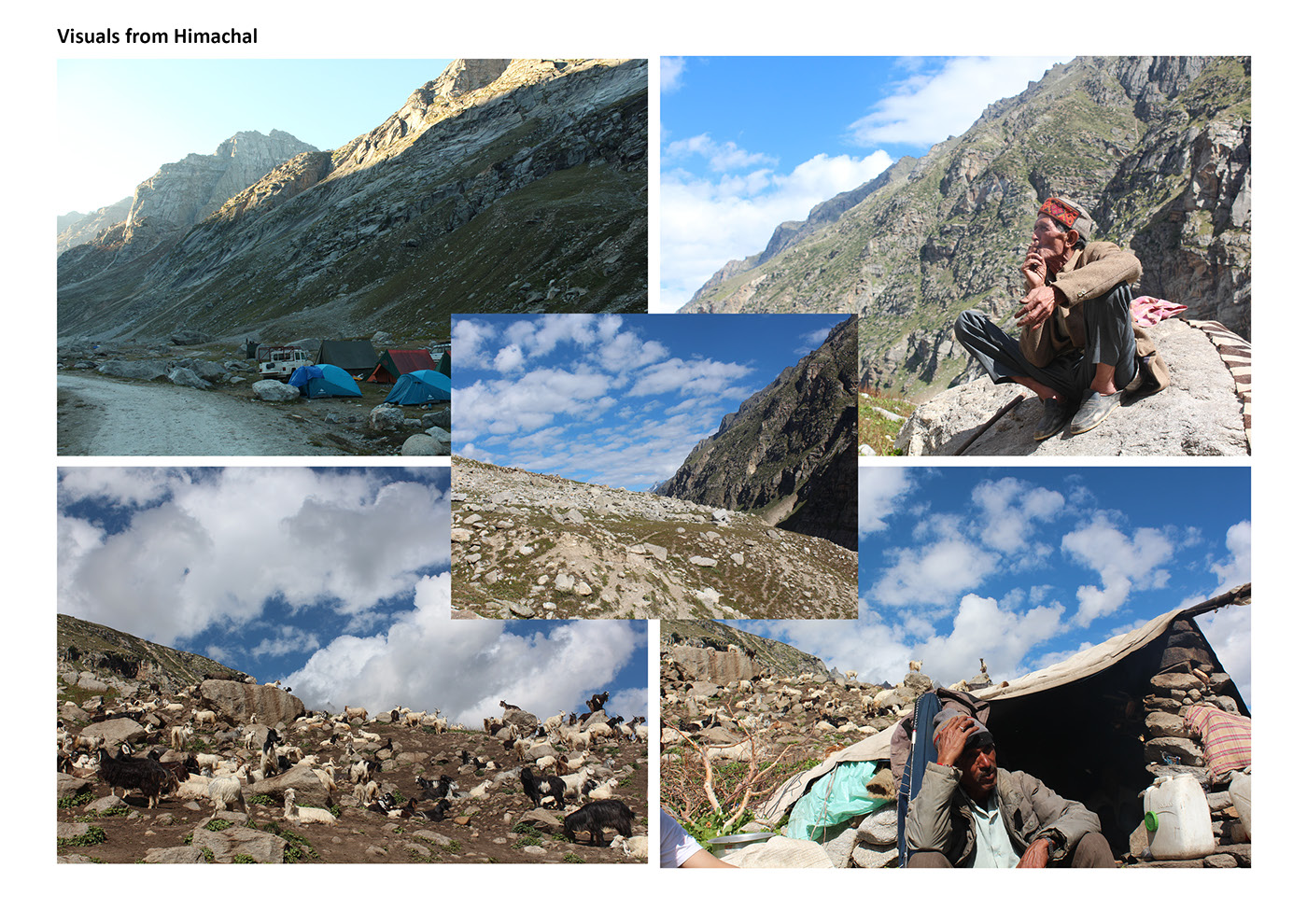

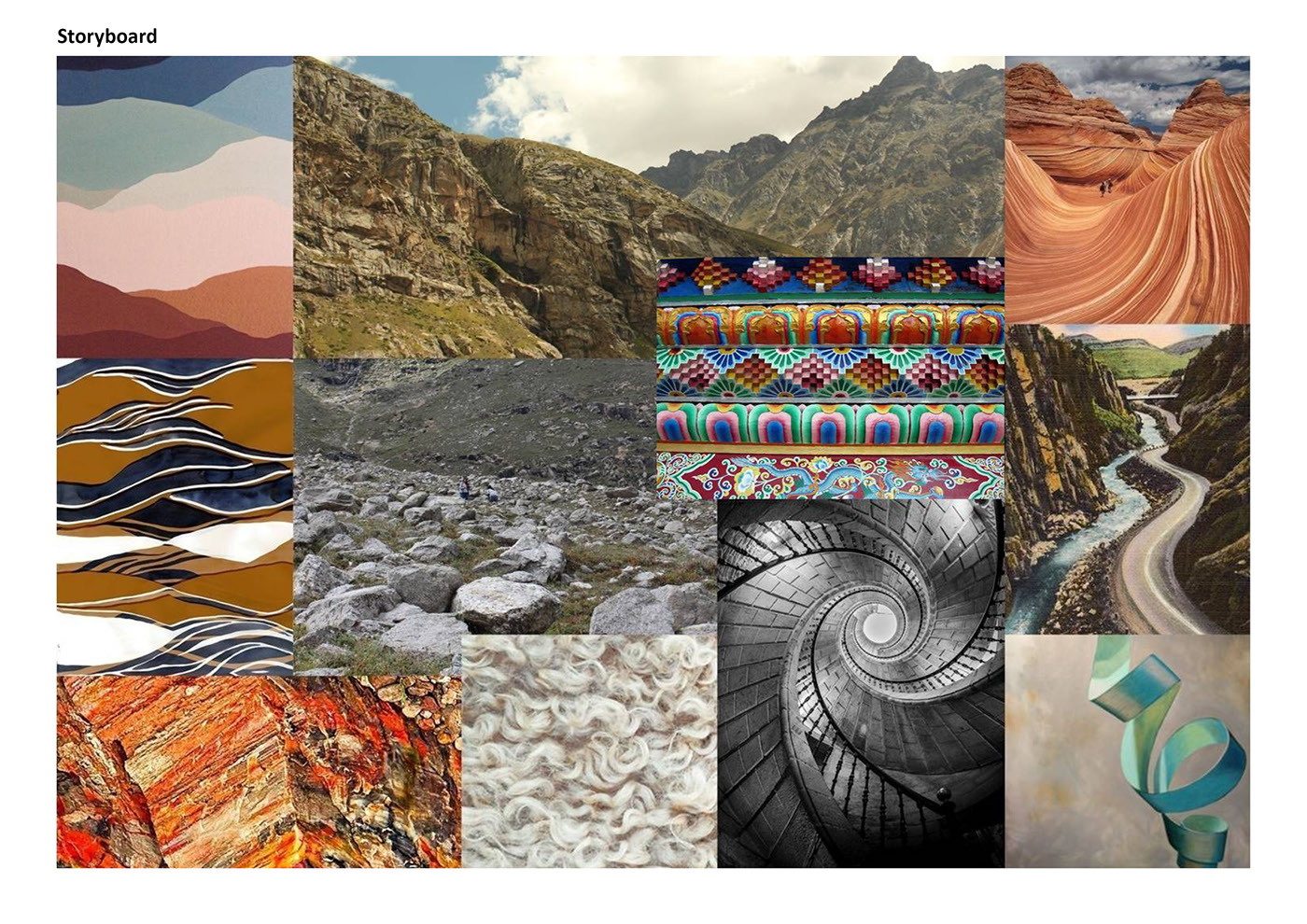
Swatch 1
40" x 20"
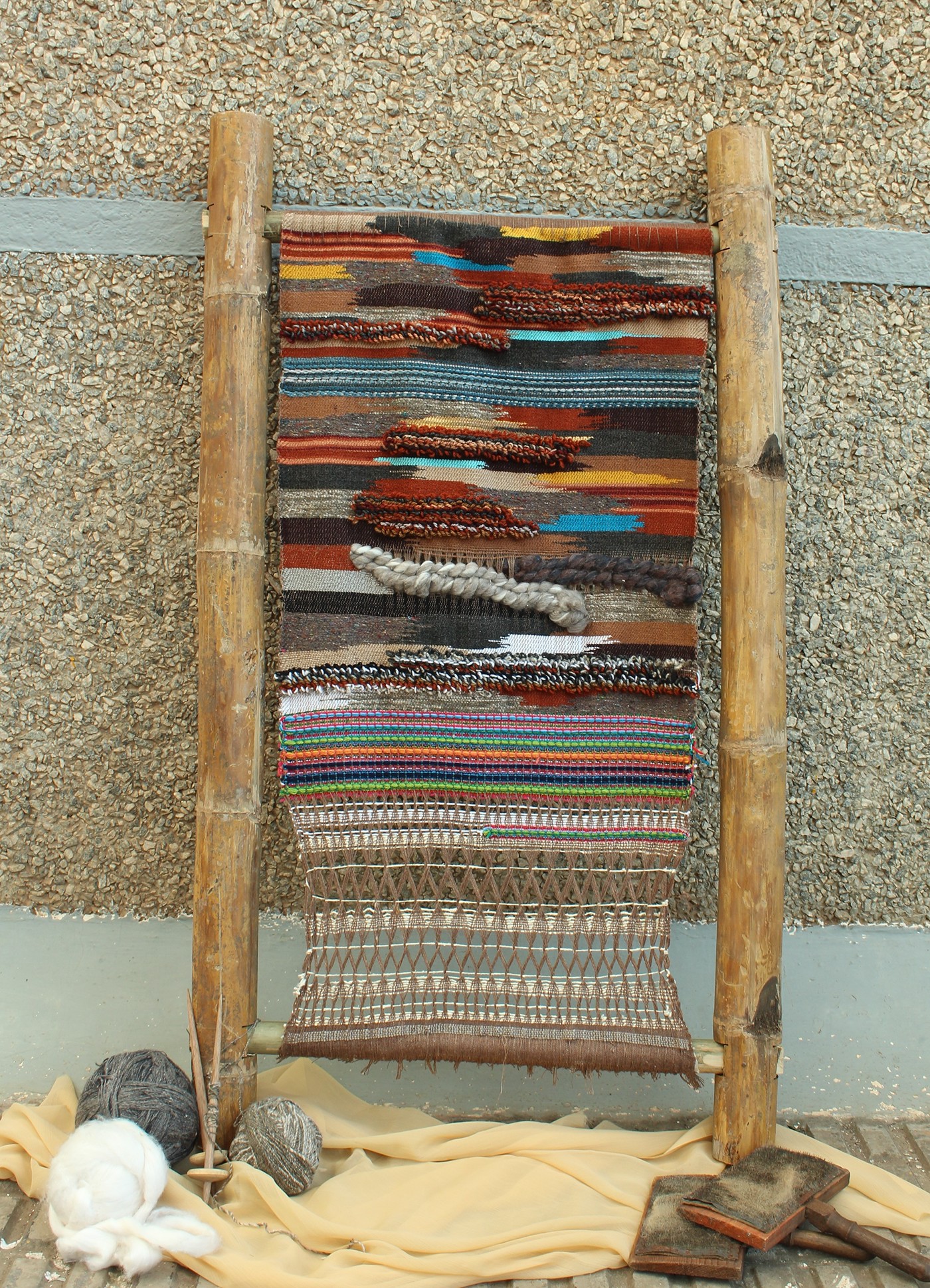

STORY 2
While working at Sapna Didi’s house, the environment made me feel quite connected to nature. We sat learning their technique of weaving, right outside their house and on the opposite side a small garden with apple trees surrounded us. People from the neighbourhood and also passers-by could see us work. Their way of working was always in the open, outside their homes. Welcoming people to see their work and chit-chat was an in-built quality they possessed. Apple with chutney was served to us as their local way of eating. They made us very comfortable in their homes. Sapna didi’s grandmother-in-law, who was 82 sat on the bed near us, very passionate about teaching and talking to us.
Suddenly, while working some news came from the neighbourhood to Sapna Didi and she quickly gathered a few bed-sheets and started covering the outside space where we were sitting beside the road. A young girl had expired in the neighbourhood and the community being very sensitive to one another, people usually stop their work for the day in the neighbourhood and give their prayers to the family. I could see Sapna Didi getting in a dilemma about this situation as we were the guests coming to learn and she couldn’t send us away , but at the same time she had to respect her community’s sentiments. She quickly covered the space with the bed sheets and managed the situation calmly. No matter how important the work is, their people and community come first.
This village has a lot of different beliefs which I had never come across until visiting here. After a person’s death, for the next 13 days a candle is lit in the house, and the entire village comes turn by turn and helps to keep it lit the entire time for the whole 13 days. They believe that after death one’s spirit is still alive and he can come back, but by doing this they say that his soul rests in peace.
While working at Sapna Didi’s house, the environment made me feel quite connected to nature. We sat learning their technique of weaving, right outside their house and on the opposite side a small garden with apple trees surrounded us. People from the neighbourhood and also passers-by could see us work. Their way of working was always in the open, outside their homes. Welcoming people to see their work and chit-chat was an in-built quality they possessed. Apple with chutney was served to us as their local way of eating. They made us very comfortable in their homes. Sapna didi’s grandmother-in-law, who was 82 sat on the bed near us, very passionate about teaching and talking to us.
Suddenly, while working some news came from the neighbourhood to Sapna Didi and she quickly gathered a few bed-sheets and started covering the outside space where we were sitting beside the road. A young girl had expired in the neighbourhood and the community being very sensitive to one another, people usually stop their work for the day in the neighbourhood and give their prayers to the family. I could see Sapna Didi getting in a dilemma about this situation as we were the guests coming to learn and she couldn’t send us away , but at the same time she had to respect her community’s sentiments. She quickly covered the space with the bed sheets and managed the situation calmly. No matter how important the work is, their people and community come first.
This village has a lot of different beliefs which I had never come across until visiting here. After a person’s death, for the next 13 days a candle is lit in the house, and the entire village comes turn by turn and helps to keep it lit the entire time for the whole 13 days. They believe that after death one’s spirit is still alive and he can come back, but by doing this they say that his soul rests in peace.
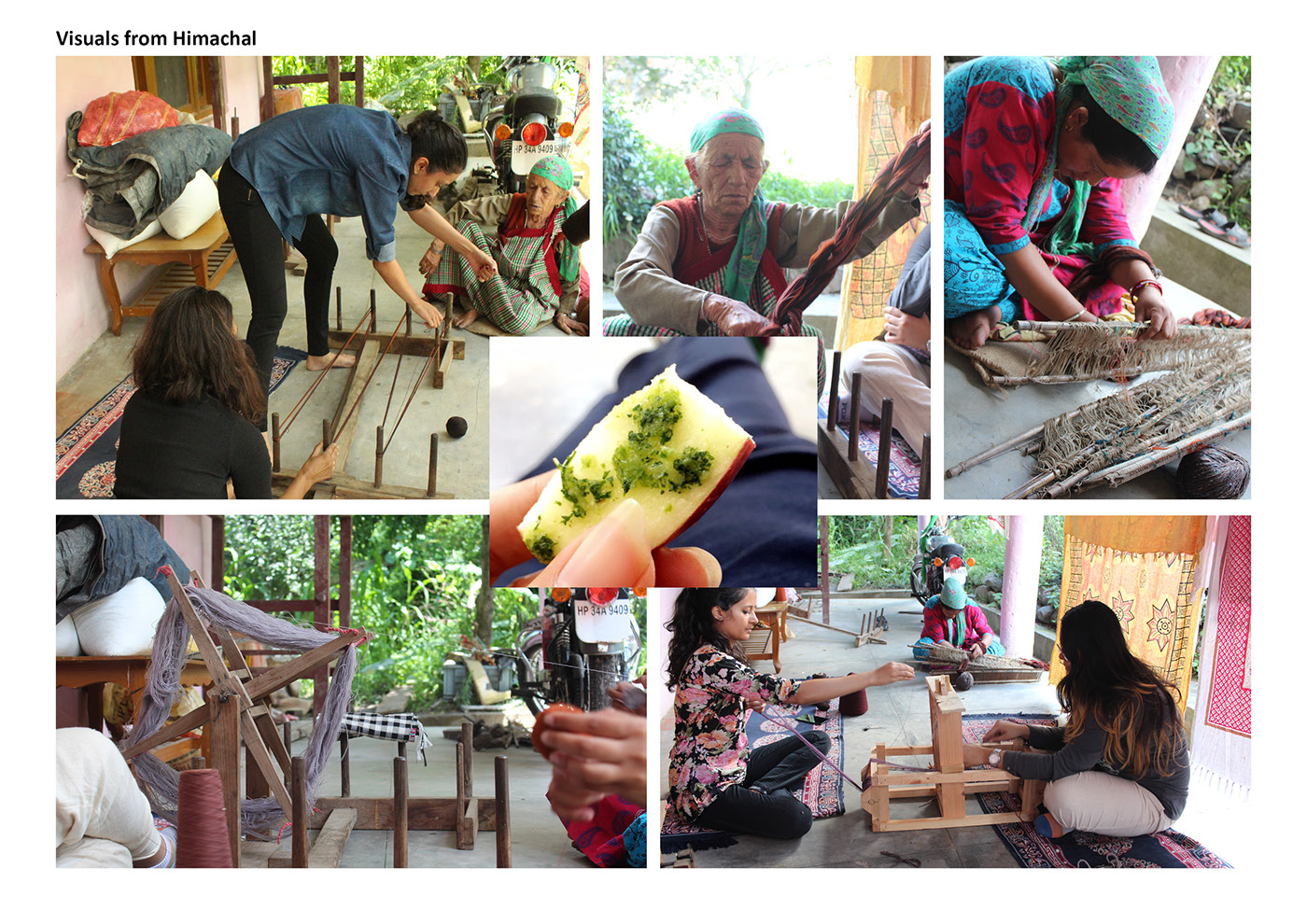

Swatch 2
40" x 20"
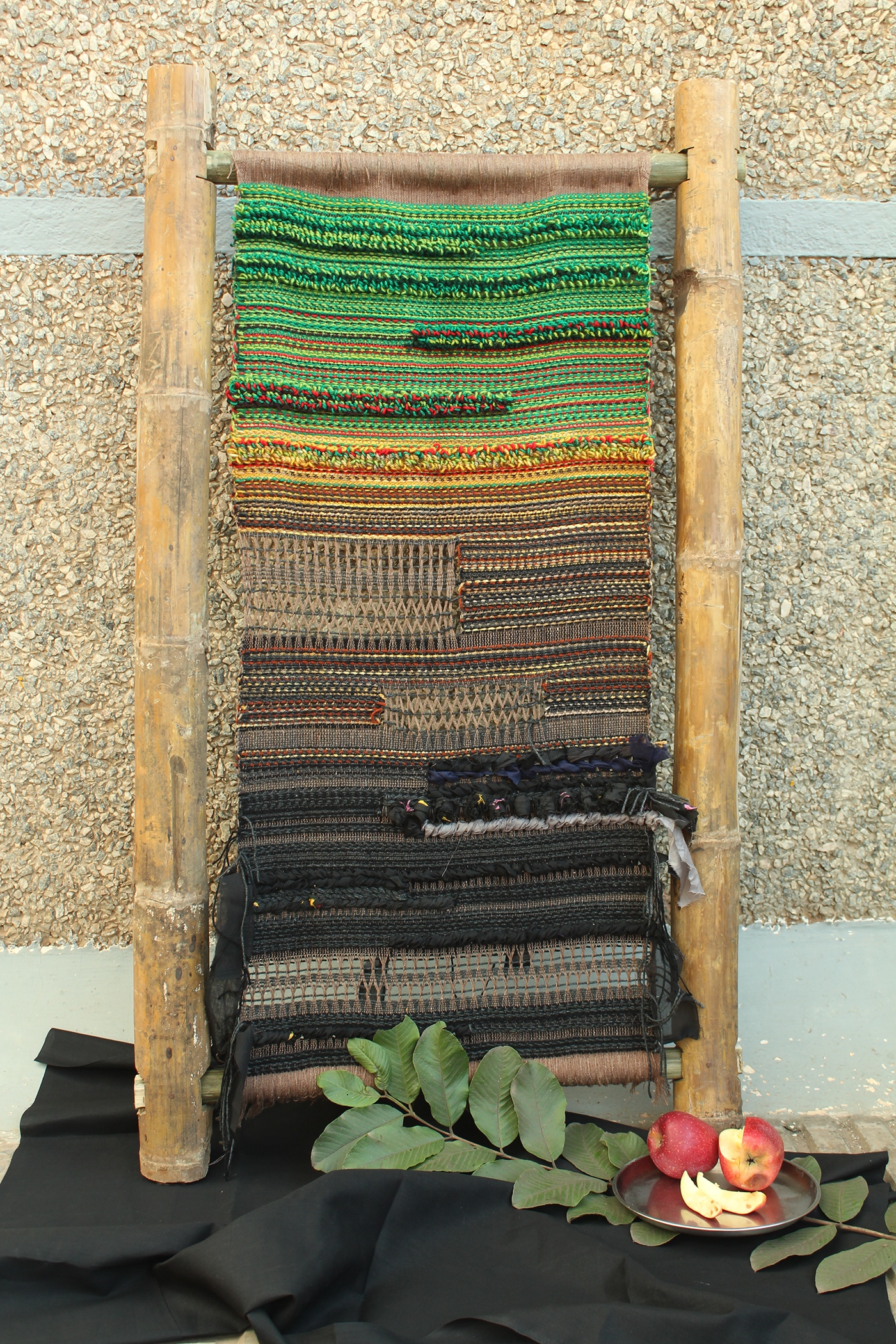

STORY 3
Pattoo, the traditional attire is a very important part of Himachali life and culture. Usually the older women weave their own pattoo’s and wear it on a daily basis. While sitting and working at Sapna Didi’s house, Dadi Ma started telling us how she used to weave pattoo’s for herself. The ritual of making and gifting pattoo’s to their daughters upon their marriage is something that they follow very seriously. Every craft that they practice is an important part of their culture. I had the experience of peeking into Dadi Ma’s wooden trunk and seeing her decade’s worth of pattoo’s. Being draped in one of these precious pieces was an unforgettable moment.
On the other side, the Himachali Topi is a sign of their pride and all over, men are seen wearing it. Other than the cultural aspect, these topi’s have a connection to the Devi. The belief in their Devi is really strong among the people of Naggar and is seen in the red and gold fabrics tied everywhere. She rules over them and everything goes according to her. It is believed that everytime she wants to talk to the people of Naggar she assigns a ‘Goor’, as messenger of God. When this happens the Himachali Topi of a man rotates and falls on the ground on its own while it’s worn on his head. This is a sign that she is going to talk through that person to the entire village.
The rootedness of the community in their traditions and how it impacts their crafts became very apparent to me through these experiences.
Pattoo, the traditional attire is a very important part of Himachali life and culture. Usually the older women weave their own pattoo’s and wear it on a daily basis. While sitting and working at Sapna Didi’s house, Dadi Ma started telling us how she used to weave pattoo’s for herself. The ritual of making and gifting pattoo’s to their daughters upon their marriage is something that they follow very seriously. Every craft that they practice is an important part of their culture. I had the experience of peeking into Dadi Ma’s wooden trunk and seeing her decade’s worth of pattoo’s. Being draped in one of these precious pieces was an unforgettable moment.
On the other side, the Himachali Topi is a sign of their pride and all over, men are seen wearing it. Other than the cultural aspect, these topi’s have a connection to the Devi. The belief in their Devi is really strong among the people of Naggar and is seen in the red and gold fabrics tied everywhere. She rules over them and everything goes according to her. It is believed that everytime she wants to talk to the people of Naggar she assigns a ‘Goor’, as messenger of God. When this happens the Himachali Topi of a man rotates and falls on the ground on its own while it’s worn on his head. This is a sign that she is going to talk through that person to the entire village.
The rootedness of the community in their traditions and how it impacts their crafts became very apparent to me through these experiences.
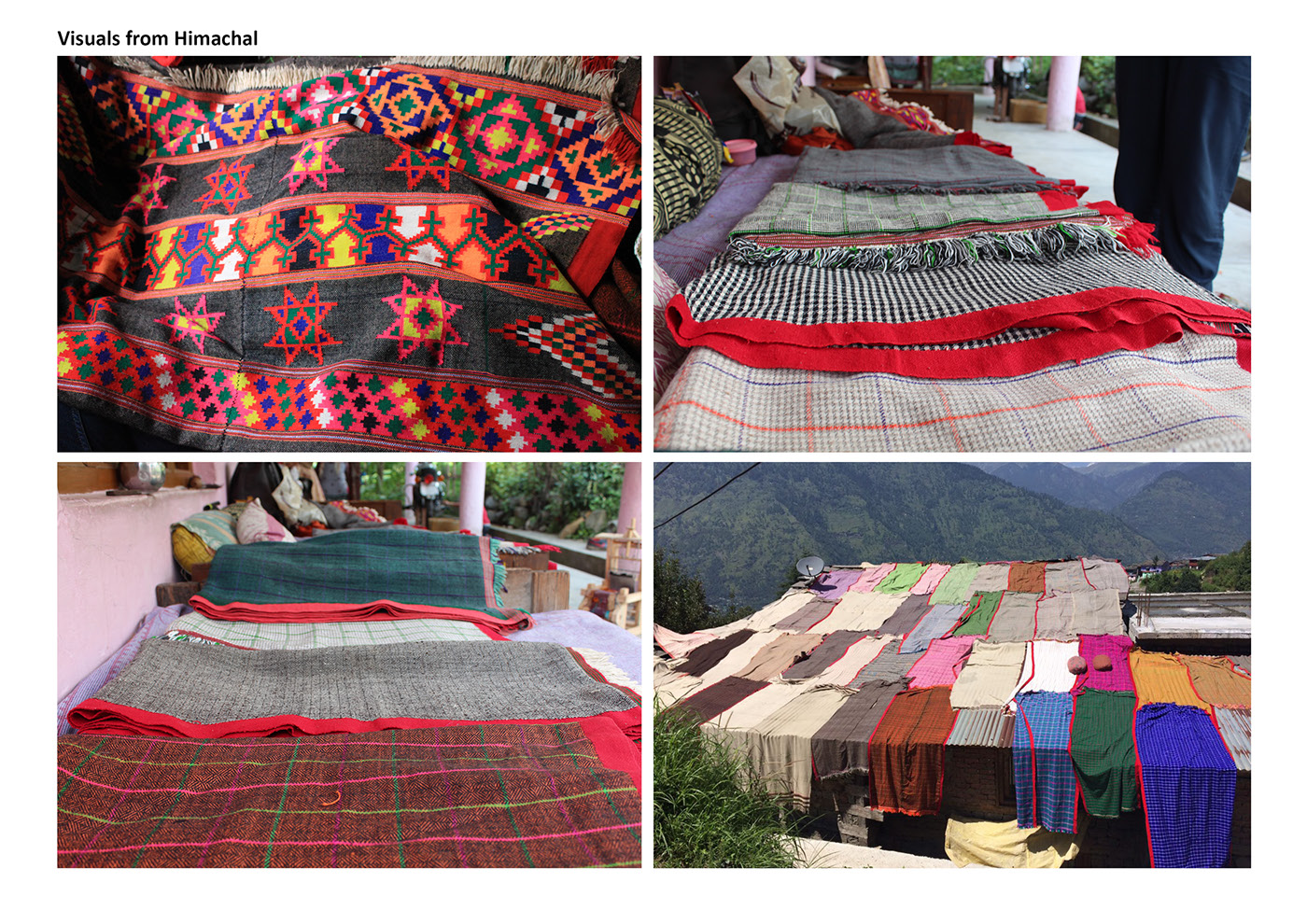
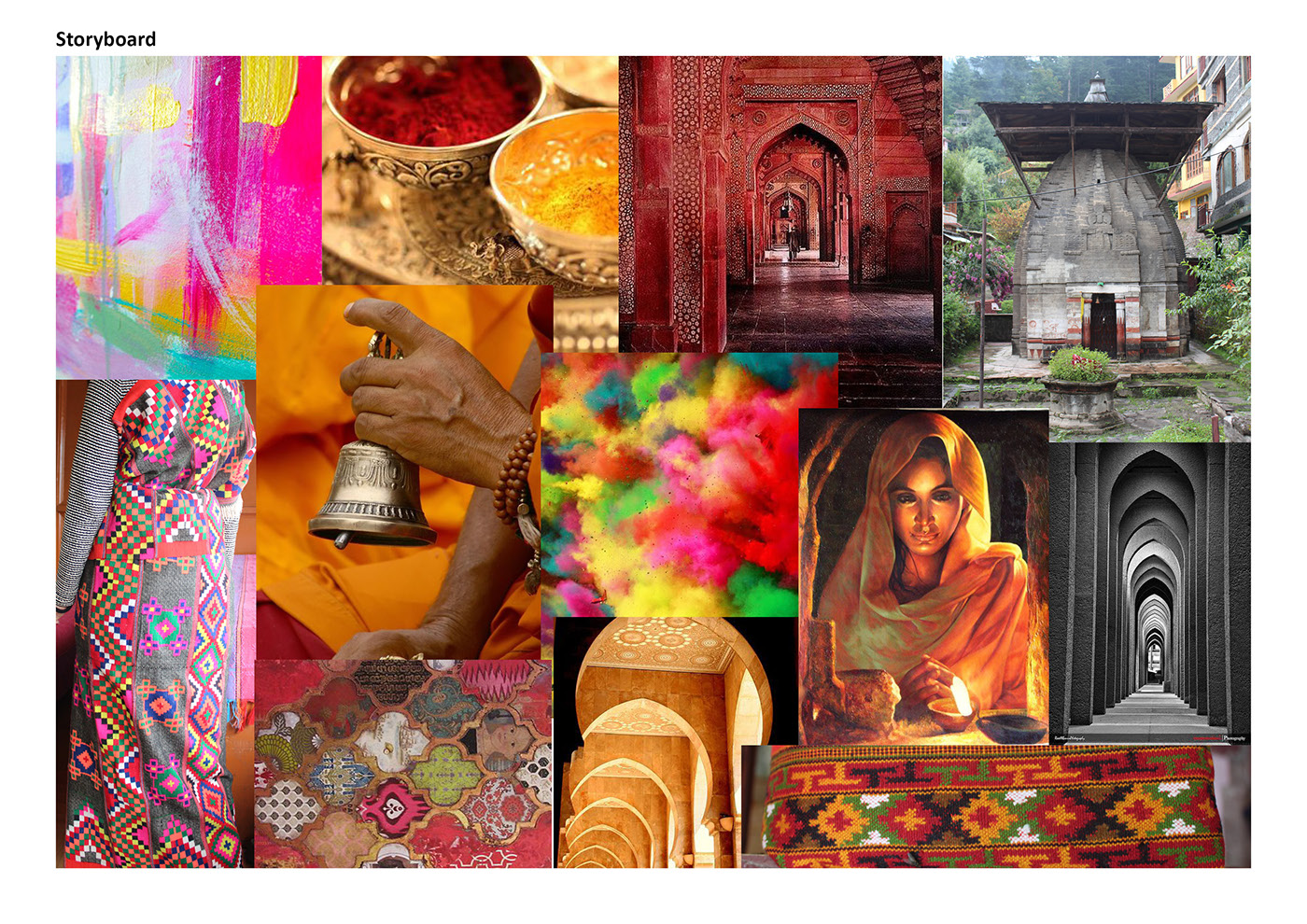
Swatch 3
40" x 20"
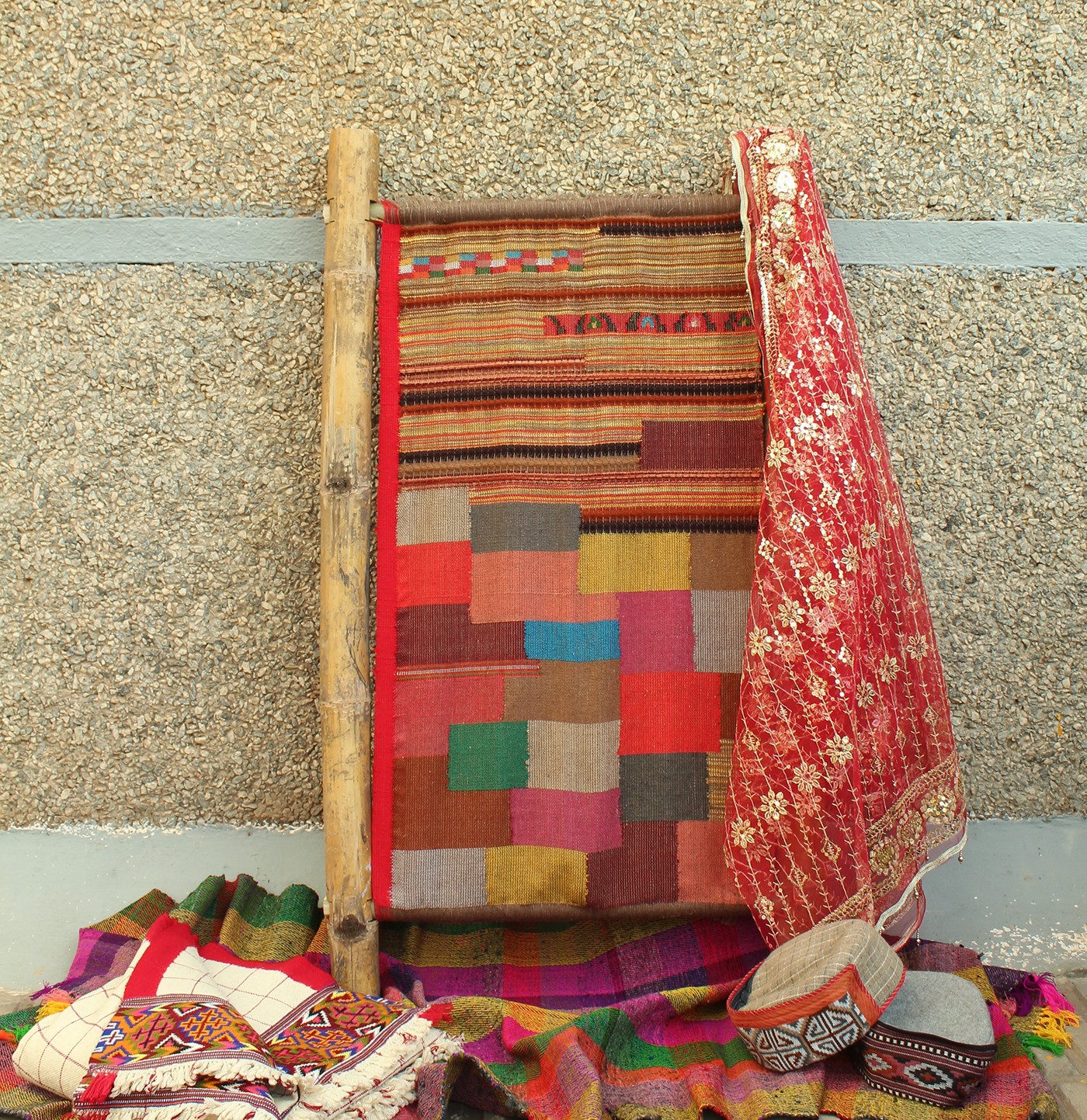

Working and staying with the artisans is a lifetime opportunity and very few people get to experience the lives and crafts of the artisans this closely. Hence my aim was to give a small overview and a new interpretation of the artisans to the people and tourists who visit Himachal or are yet to visit.


